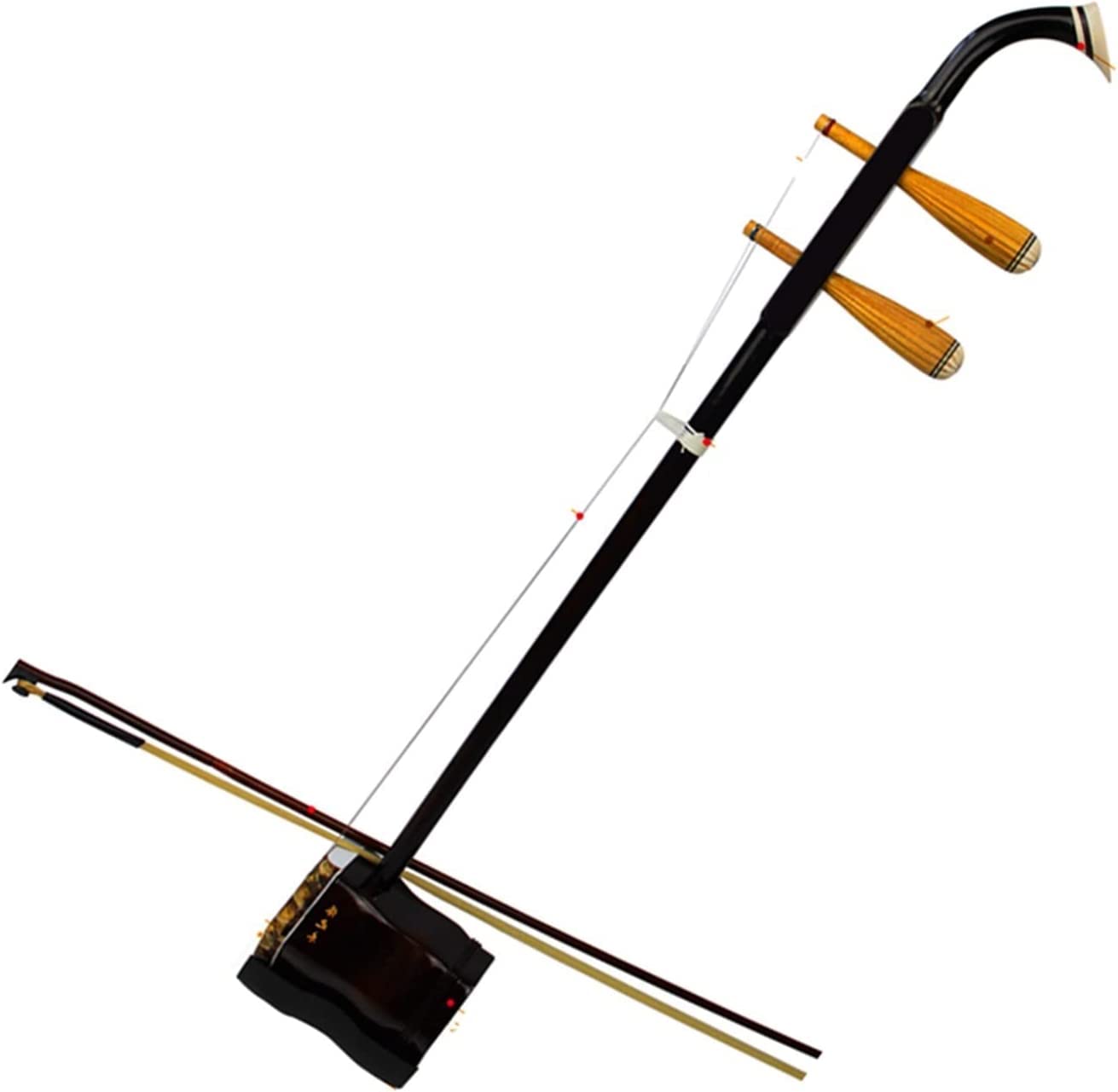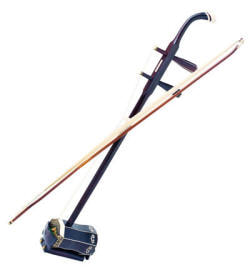Erhu
Bowed Instruments
Asia
Between 0 and 1000 AD
Video
The Erhu is one of the most iconic and expressive instruments in traditional Chinese music. Its haunting, melodic sound can convey a wide range of emotions, from deep sorrow to exuberant joy. The Erhu, often referred to as the “Chinese violin” or “Chinese two-stringed fiddle,” has a rich history and plays a significant role in the cultural and musical heritage of China. Its versatility and distinct sound make it an essential instrument in Chinese orchestras, as well as in solo performances.
History and Origin of the Erhu
The Erhu is believed to have originated during the Tang Dynasty (618–907 AD) and has evolved significantly since then. It is thought to have been derived from instruments brought to China through cultural exchanges with Central Asia, particularly the Persian “rabab” and the Mongolian “morin khuur,” both of which are stringed instruments played with a bow. Early forms of the Erhu were known as “Xiqin” or “Huqin,” a term used to describe a family of Chinese bowed string instruments.
The development of the Erhu as we know it today can be traced back to the Song Dynasty (960–1279 AD). During this time, the instrument began to gain popularity among the Chinese people, especially in the southern regions of the country. By the Ming Dynasty (1368–1644), the Erhu had become widely used in various Chinese operas, traditional music ensembles, and even in royal courts. Its rich, expressive sound became an essential part of Chinese cultural events and performances.
Throughout the centuries, the Erhu has been adapted and refined, with variations in its design, tuning, and playing techniques. While it was originally made with a smaller, more simple body, the Erhu gradually evolved into the more sophisticated and finely crafted instrument we know today. In the 19th and early 20th centuries, the Erhu experienced a surge in popularity as part of the revitalization of traditional Chinese music, especially during the Republican era (1912–1949), when many classical art forms were promoted.
Today, the Erhu continues to be an essential part of Chinese music, both in traditional settings and modern interpretations. It is featured in Chinese opera, folk music, and contemporary compositions, and has even found its way into popular music genres. The Erhu’s ability to blend with other instruments and adapt to various styles of music has made it a lasting and revered part of China’s musical legacy.
Working Mechanism and Features of the Erhu
The Erhu is a two-stringed instrument that is played using a bow. It is a member of the “huqin” family, which includes other Chinese bowed instruments such as the Zhonghu and the Gaohu. The Erhu is known for its distinctive shape and design, as well as its ability to produce a wide range of expressive sounds, from soft, delicate notes to sharp, dramatic cries.
Structure and Design
The Erhu has a simple yet elegant design. It consists of a long, straight neck made of wood, typically rosewood or ebony, and a small, cylindrical body. The body is traditionally made from a hollowed-out wooden frame or a resonator box, with a thin layer of snakeskin stretched over the top. This snakeskin covering acts as a membrane that vibrates when the strings are played, amplifying the sound produced by the instrument.
- The instrument’s two strings are made of steel or silk, with one string tuned to a lower pitch and the other to a higher pitch. The strings are stretched from a small peg at the top of the neck to a bridge located on the resonator box. The bridge serves to transmit the vibrations of the strings to the body of the instrument, enhancing the sound.
- The Erhu does not have a fingerboard like the violin. Instead, the player adjusts the pitch of the notes by pressing the strings directly onto the neck, allowing for smooth glissandos and expressive slides. The lack of a fingerboard also means that the Erhu can produce subtle nuances in pitch, creating a more emotive and fluid sound.
A key characteristic of the Erhu is the bow, which is made from a flexible wooden stick with a horsehair stretched between the ends. The bow is used to create friction against the strings, producing the instrument’s signature sound. Unlike Western stringed instruments, the bow of the Erhu is not held between the fingers. Instead, the bow is held by the player’s hand, with the palm facing upward and the fingers grasping the bow at the bottom.
Sound Production
The sound of the Erhu is often described as melancholic, mournful, and expressive. The two strings are tuned to a fifth interval, with the lower string producing a deep, resonant tone and the higher string producing a bright, clear sound. The player can produce a wide range of dynamics and tonal qualities by varying the pressure and speed of the bow, as well as by using techniques such as vibrato, glissando, and pizzicato.
The Erhu’s sound is highly dependent on the player’s technique, as the instrument requires precise control of both the bow and the fingers. The bowing technique is particularly important, as the player must strike the strings with just the right amount of pressure to create the desired sound. Too little pressure results in a faint, weak sound, while too much pressure can produce a harsh, screeching tone. The player can adjust the dynamics of the sound by altering the bow’s speed and pressure, allowing for dramatic shifts in volume and tone. The Erhu can also produce a variety of effects, such as slides, trills, and tremolos, which give it a distinctive voice in both solo and ensemble settings. The pitch can be varied subtly by sliding the fingers along the neck, allowing the player to create smooth transitions between notes or dramatic shifts in tone.
Playing Techniques
The Erhu is typically played with the right hand holding the bow and the left hand pressing the strings on the neck. The player moves the bow across the strings in a smooth, controlled motion, using the left hand to press the strings and adjust the pitch. The absence of a fingerboard means that the player must rely on their ear and muscle memory to find the correct pitches.
One of the most important playing techniques is vibrato, where the player oscillates the pitch of the note by rapidly moving the left hand. This technique gives the sound a warmer, more emotional quality and is often used to convey deep emotion in traditional Chinese music. Another common technique is glissando, where the player slides their fingers along the neck of the instrument, creating a smooth, continuous change in pitch. This technique is particularly effective for expressing sorrow or longing in Chinese music.
Types of Erhu and Their Features
While the basic design of the Erhu remains consistent, there are several variations of the instrument, each suited to different musical styles and settings. The different types of Erhu vary in size, range, and tone.
The Standard Erhu
The standard Erhu, also known as the “huqin,” is the most commonly used version of the instrument. It has a range of about three octaves and is used in a wide variety of musical genres, including traditional Chinese folk music, classical music, and opera. The standard Erhu is typically tuned to the pitches D and A, though different tunings may be used depending on the musical context. The standard Erhu is versatile and can be used for both melodic and accompaniment purposes. It is a prominent feature in Chinese orchestras and is often featured in solo performances. The sound produced by the standard Erhu is bright and resonant, with a broad dynamic range.
The Gaohu
The Gaohu is a smaller version of the Erhu, with a higher pitch range. It is often used in Cantonese opera and other southern Chinese musical traditions. The Gaohu is tuned higher than the standard Erhu and is known for its bright, piercing tone. Because of its higher pitch, it is often used to convey lively, energetic music in Chinese opera and other performance arts.
The Zhonghu
The Zhonghu is a larger version of the Erhu, with a deeper, more resonant tone. It is tuned lower than the standard Erhu and is often used in Chinese orchestras to provide harmonic support. The Zhonghu’s rich, warm sound makes it ideal for playing slower, more dramatic music and creating a sense of depth in orchestral arrangements.
The Erhu is an instrument that has stood the test of time, remaining a cornerstone of traditional Chinese music. Its rich history, combined with its unique construction and playing techniques, has allowed it to evolve into a symbol of Chinese culture. Whether used in solo performances or as part of an orchestra, the Erhu’s expressive, emotive sound continues to captivate audiences around the world. With its versatility and ability to convey a wide range of emotions, the Erhu remains one of China’s most beloved musical instruments, both in traditional and contemporary music.
FAQ
What is the composition of the Erhu musical instrument?
The Erhu is a traditional Chinese bowed string instrument consisting of two strings, a hollowed-out wooden soundbox (typically made of sandalwood or other dense woods), and a long neck. The soundbox is covered with a thin membrane, often made from python skin, which enhances its resonance. The instrument does not have a fingerboard, and pitch is adjusted by pressing the strings with the fingers on the neck, much like other bowed string instruments.
What are the key characteristics of the Erhu?
The Erhu is known for its expressive, rich, and mournful sound, which allows for great emotional depth in performance. Its range typically covers about three octaves. The instrument is played with a bow that is inserted between the two strings. Its high-pitched, penetrating sound can evoke a range of emotions, from sorrow to joy. The Erhu’s simple design allows for quick portability, making it widely used in both orchestras and solo performances.
What type of music is the Erhu used for?
The Erhu is versatile and used in a wide range of music genres in China. It is integral to traditional Chinese music, often heard in operas, folk music, and classical performances. The Erhu is also used in modern music, including film scores, pop music, and fusion genres. Its ability to convey deep emotion makes it a popular choice for soundtracks in movies and television shows, particularly in scenes requiring a sorrowful or nostalgic atmosphere.
How is the Erhu played?
The Erhu is played by holding the instrument vertically, with the left hand pressing down on the strings along the neck to change the pitch, while the right hand holds the bow. The bow is drawn across the strings, and the pitch is modified by the fingers of the left hand. The lack of a fingerboard requires the player to rely on their ear to find precise notes. Skilled players can create a wide range of tones, from sharp, high-pitched sounds to soft, melancholic melodies.
 Links
Links
References
Other Instrument
Categories



















